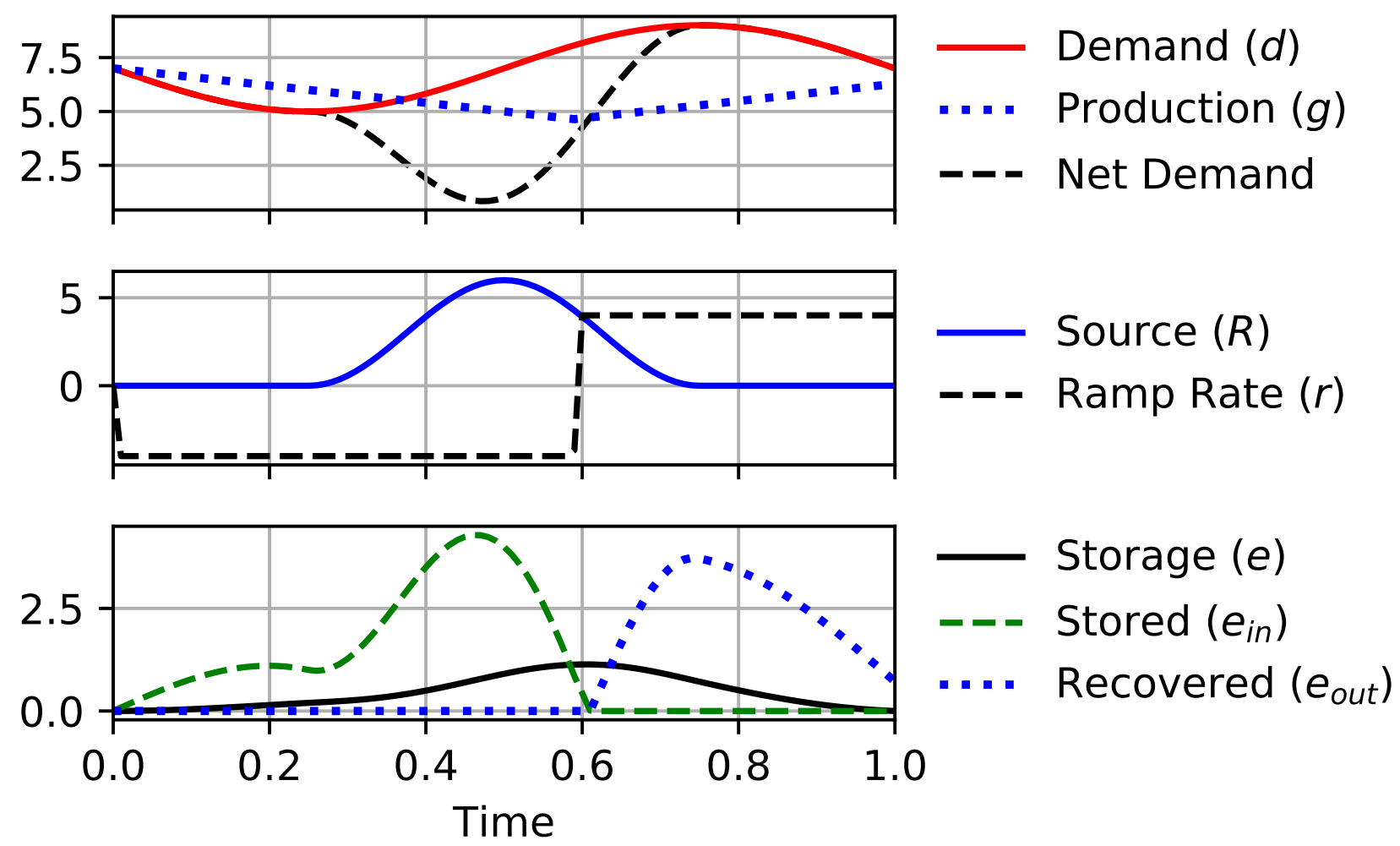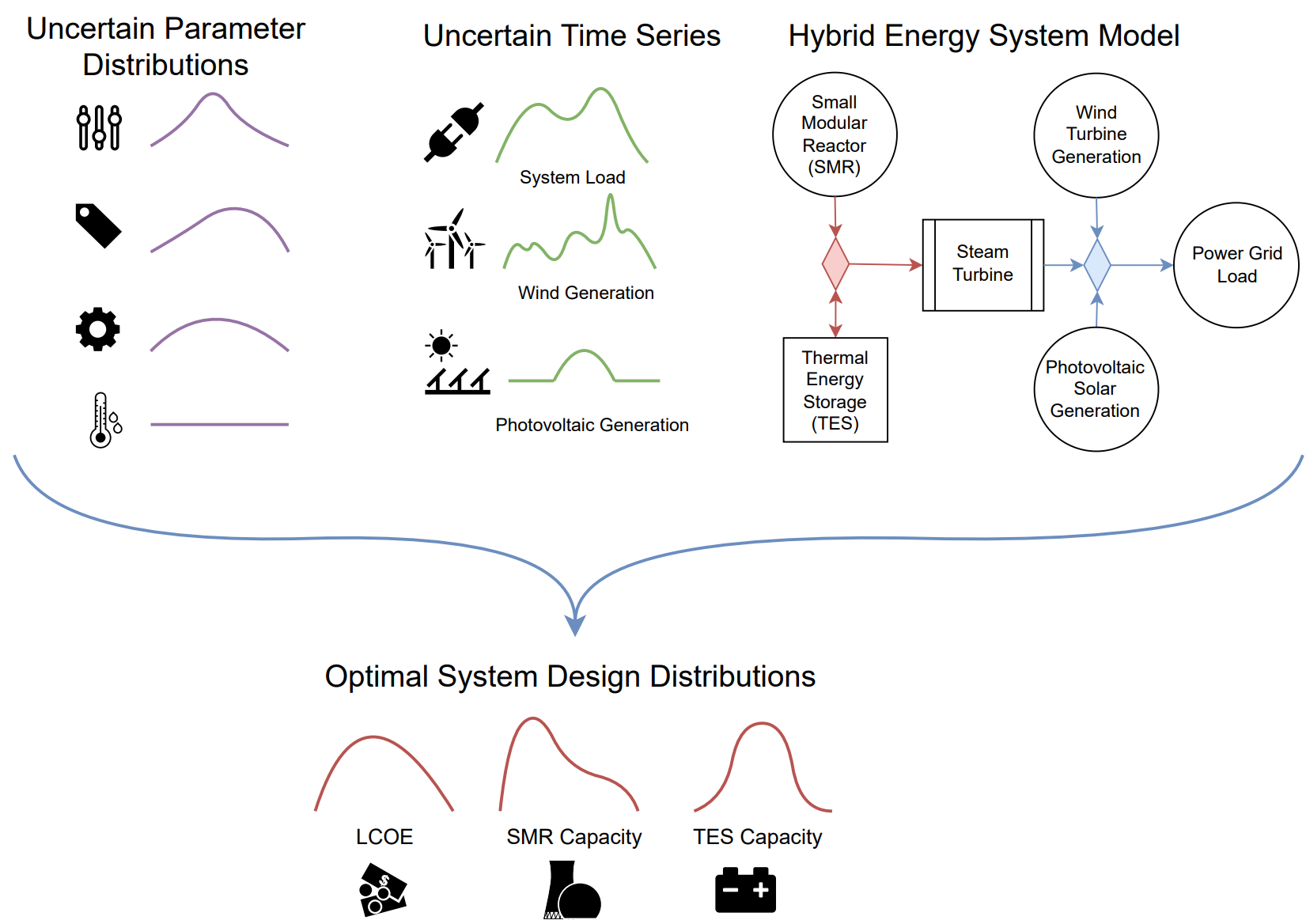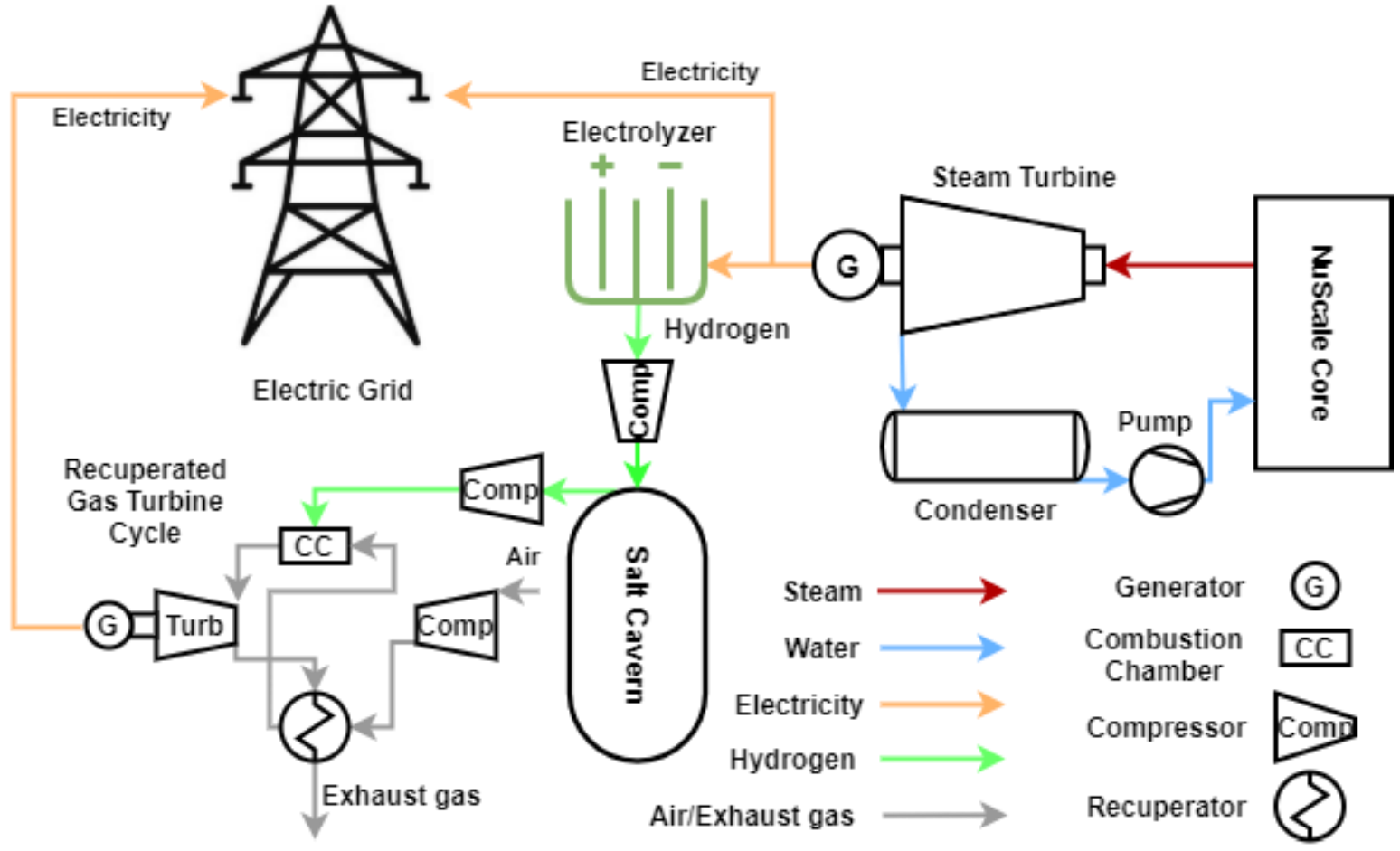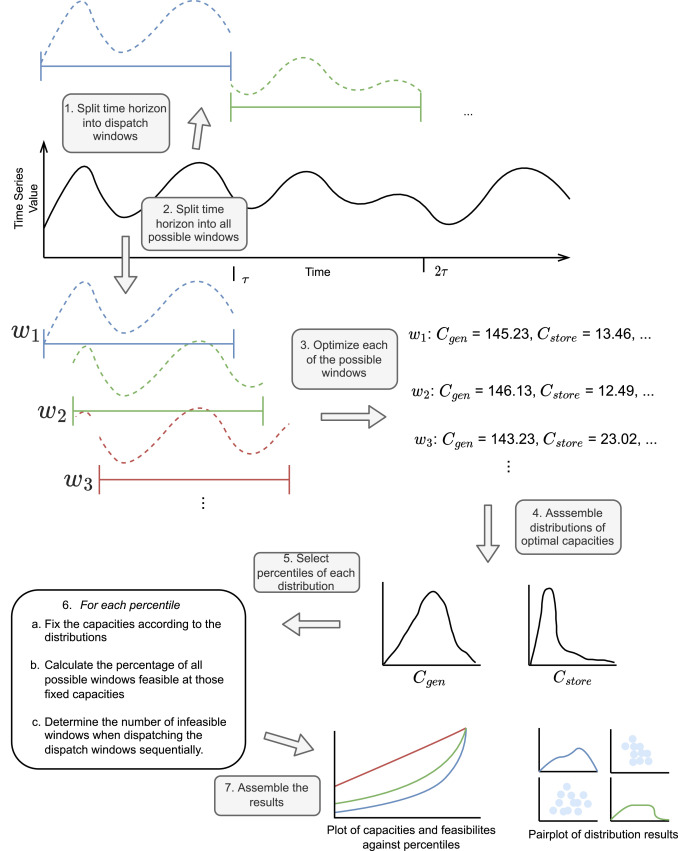This project develops new capabilities of design and dispatch optimization of nuclear hybrid energy systems (NHES) in the "Risk Analysis Virtual Environment (RAVEN)" modelling software. Blended (physics-based and data-driven) machine learning will be applied to forecast demand and production of thermal and electrical loads.
Two experimental case studies are proposed to test the software developments with a lab-scale thermal energy storage and with a large district energy system. As a final step, the software developments will be generalized to other NHES.
Support for this research comes from the DOE NEUP Project 19-16879: Proactive Hybrid Nuclear with Load Forecasting. This project is a collaboration between BYU Process Research and Intelligent Systems Modeling (PRISM) Group, the Energy Systems Research Group at the University of Utah, and Idaho National Labs (INL).
Publications
NHES with H2 Storage
Ho, A., Mohammadi, K., Hedengren J.D., Memmott, M., Powell, K.M., Dynamic simulation of a novel nuclear hybrid energy system with large-scale hydrogen storage in an underground salt cavern, International Journal of Hydrogen Energy, 29 July 2021.
Preprint |
Article

Abstract: In this study, a nuclear hybrid energy system (NHES) with large-scale hydrogen storage integrated with a gas turbine cycle is proposed as a flexible system for load following. The proposed system consists of a nuclear reactor, a steam Rankine cycle, a hydrogen electrolyzer, a storage system for hydrogen in an underground salt cavern, and a Brayton cycle that uses hydrogen as fuel to generate additional electricity to meet peak demand. A dynamic mathematical model is developed for each subsystem of the NHES. To evaluate the potential benefits of the system, a one-year study is conducted, using scaled grid demand data from ISO New England. The dynamic simulation results show that the system is capable of meeting the demand of the grid without additional electricity from outside sources for 93% of the year, while decreasing the number of ramping cycles of the nuclear reactor by 92.7%. There is also potential for economic benefits as the system only had to ramp up and down 7.4% of the year, which increased the nuclear capacity factor from 86.3% to 98.3%. The simulation results show that the proposed hybrid system improves the flexibility of nuclear power plants, provides more electricity, and reduces greenhouse gas emissions.
Grid Energy Benchmarks
Gates, N.S., Hill, D.C., Billings, B.W., Powell, K.M., Hedengren, J.D., Benchmarks for Grid Energy Management with Python Gekko, 60th Conference on Decision and Control (CDC), Austin, TX, USA, December 13-15, 2021.
Preprint |
Benchmarks

Abstract: Recent grid energy problems in California and Texas highlight the need for optimized grid design and operation. The complexity of the electric grid presents difficult control problems that require powerful solvers and efficient formulations for tractable solutions. The Gekko Optimization Suite is a machine learning and optimization package in Python for optimal control with differential algebraic equations and is capable of solving complex grid design and control problems. A series of non-dimensional benchmark cases are proposed for grid energy production. These include (I) load following, (II) cogeneration, (III) tri-generation, and energy storage with (IV) constant production, (V) load following, and (VI) cogeneration. Individual case studies include ramp rate constraints, power production, and energy storage operation as design variables. The tutorials demonstrate methods to solve control problems with sequential and simultaneous solutions of the objective and dynamic constraints. While these tutorials are specific to grid energy system optimization, the tutorials also demonstrate how to efficiently solve large-scale nonlinear dynamic systems with a trade-off analysis between sequential and simultaneous methods.
Small Modular Reactor Hybrid Energy System
Hill, D., Martin, A., Martin-Nelson, N., Granger, C., Memmott, M., Powell, K., Hedengren, J.D., Techno-economic sensitivity analysis for combined design and operation of a small modular reactor hybrid energy system, International Journal of Thermofluids, Volume 16, 100191, November 2022.
Preprint |
Article (Open Access)

Abstract: With increasing grid-penetration of renewable energy resources and a rising need for carbon-free dispatchable power generation, nuclear-hybrid energy systems (NHES), consisting of small modular reactors, are an increasingly attractive option for maintaining grid stability. NHES can accomplish this with a minimal carbon footprint but there are significant uncertainties that are not fully understood. This work describes and demonstrates methods for analyzing the uncertainties of potential NHES designs, including uncertain design parameters and time series as well as variations in dispatch horizon length. The proposed methods are demonstrated on a sample system with 16 design parameters, 3 uncertain time series, and a range of dispatch horizon lengths where the unit capacities and unit dispatch are co-optimized to minimize system LCOE. For the example system, 11 of 16 parameters are uncorrelated with model outputs, allowing for model reduction without decreased accuracy. It is determined that the impact of variation in multiple time series cannot be easily isolated and that the examined sources of uncertainty are of similar importance in terms of overall impact.
Nuclear Hydrogen Hybrid Energy System
Ho, A., Hill, D., Hedengren J.D., Powell, K.M., A nuclear-hydrogen hybrid energy system with large-scale storage: A study in optimal dispatch and economic performance in a real-world market, Journal of Energy Storage, Volume 51, 104510, July 2022, DOI: 10.1016/j.est.2022.104510
Article

Abstract: A study in optimal dispatch and economic analysis of a novel nuclear hybrid energy system (NHES) with large-scale hydrogen storage and a novel control scheme is conducted. The control scheme makes charge and discharge decisions by using the real-time electricity price relative to the historical price distribution. The pricing data is taken from the ERCOT Houston and West load zones with different price oscillations. Six case control studies with different levels of aggressiveness were chosen for each load zone for a total of 12 case studies. It is found that in a high price volatility load zone, a more aggressive control strategy maximizes revenue, while in a less oscillatory load zone, a moderate control strategy performs better. The NHES can store energy when the price is low and sell additional electricity when the price is high, as well as participate in the ancillary services market. Due to these advantages, the NHES can generate 10–40 million USD more revenue annually than a stand-alone nuclear plant. Due to higher costs, the NHES has a higher LCOE (81.36 USD/MWh) than a stand-alone plant (68.66 USD/MWh); however, the LCOE of the NHES is still comparable to other new forms of electricity generation. It is found that both the NHES and the stand-alone plant are not economical in the existing electricity market. Due to the extra revenue generated, the hybrid system has a positive annual cashflow whereas the stand-alone plant does not. It is found that the hybrid plant needs less cost subsidy than a stand-alone plant to become economical.
A Multi-Scale method for combined design and dispatch optimization of nuclear hybrid energy systems including storage
Hill, D., McCrea, D., Ho, A., Memmott, M., Powell, K., Hedengren, J., A Multi-Scale method for combined design and dispatch optimization of nuclear hybrid energy systems including storage, e-Prime - Advances in Electrical Engineering, Electronics and Energy, Volume 5, 2023, 100201, ISSN 2772-6711, DOI: 10.1016/j.prime.2023.100201
Article (Open Access)

Abstract: Reliable, carbon-free power generation is increasing in importance. Nuclear-renewable hybrid energy systems (NHES) are a potential solution for current generation challenges, but design and dispatch optimization for these systems remains challenging particularly when stochastic effects, long time horizons and nonlinear modeling are needed. This work presents a multi-scale method for combining the design and dispatch optimization problems for nonlinear NHES over long time horizons. Rather than treating the entire horizon as a single optimization problem, a large number of combined optimization problems are solved for shorter samples of the horizon resulting in distributions of optimal capacities for each of the capacities being optimized. The distributions are then aggregated, and the techno-economics of each aggregate is analyzed. The result is a contextual knowledge about the techno-economic tradeoffs for the system rather than a single set of optimal capacities. This method is applied to two NHES of varying complexity. Results indicate that unit capacities for a grid-connected district energy system can be reduced by at least 18.9% by allowing for 3 periods of power import over the course of a 2000 day dispatch. The algorithm is used to solve combined optimization problems with dispatch horizons 112.5 times longer than are solvable directly.






